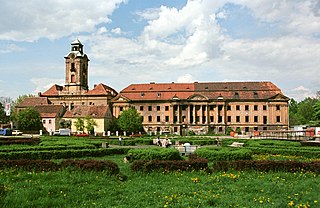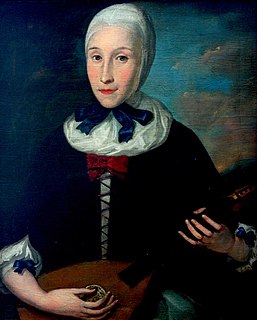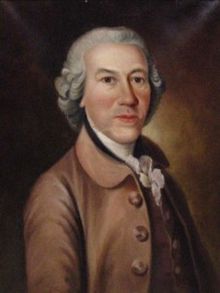
Countess Augusta Caroline Sophie Reuss-Ebersdorf, was by marriage the Duchess of Saxe-Coburg-Saalfeld. She was the maternal grandmother of Queen Victoria and the paternal grandmother of Albert, Prince Consort.

Saalburg-Ebersdorf is a town in the Saale-Orla-Kreis district, in Thuringia, Germany close to the Bavarian border. It is situated on the river Saale, 10 km southwest of Schleiz, 30 km west of Plauen and 30 km north-west of Hof.

Reuss-Ebersdorf was a county and from 1806 a principality located in Germany. The Counts of Reuss-Ebersdorf belonged to the Reuss Junior Line. Reuss was successively a part of the Holy Roman Empire, Confederation of the Rhine, German Confederation, North German Confederation, German Empire and Weimar Republic before becoming a part of Thuringia in 1920.

Heinrich XXIV, Count Reuss of Ebersdorf, was ruler of the German county Reuss-Ebersdorf from 1747 till his death.

Imperial Count Christian Renatus von Zinzendorf und Pottendorf was the charismatic leader of the Single Brethren's Choir of the Moravian Church and of Herrnhaag, a Christian religious community built near Büdingen by his father, Count Nicholas Ludwig, head of the Brüdergemeine or Moravian Unity. Christian Renatus, affectionately known as Christel, took his father’s marriage religion (Ehereligion) literally, proclaiming himself to be the living "Sidewound of Christ" in 1748, which meant he was the embodiment of Christ's sacrificial and compassionate love.

Heinrich IV, Prince Reuss was the head of the German Princely House of Reuss.

Heinrich XI, Prince Reuss of Greiz was the first Prince Reuss of Greiz from 1778 to 1800.

Countess Johanna Sophia of Hohenlohe-Langenburg was a German noblewoman by birth and by marriage Countess of Schaumburg-Lippe.
Henry Frederick, Count of Hohenlohe-Langenburg was the youngest child of Count Philip Ernest of Hohenlohe-Langenburg and his wife Countess Anna Maria of Solms-Sonnewalde.
Sophie Christiane of Wolfstein was a Countess of Wolfstein by birth and Margravine of Brandenburg-Bayreuth-Kulmbach by marriage.

Erdmann II, Count von Promnitz was Lord of Żary and Trzebiel in Lower Lusatia, and Pszczyna in Upper Silesia.
Heinrich X, Count of Reuss-Ebersdorf, was a member of the House of Reuss. He was Count of Lobenstein, and from 1678, Count of Ebersdorf. He was the founder of Reuss-Ebersdorf line.

Henry II of Reuss , nicknamed the Posthumous because his father died two months before he was born, was Lord of Gera, Lord of Lobenstein and Lord of Oberkranichfeld.

Erdmuthe Dorothea, Countess of Zinzendorf, née Countess of Reuss-Ebersdorf was a German Pietist and hymn writer.
Benigna Marie of Reuss-Ebersdorf was a Protestant German hymn writer and a titular Countess of Reuss. She was a member of the Reuss-Ebersdorf line from the Reuss-Lobenstein.
George August was the Count of Erbach-Schönberg and an Imperial counselor.
Sophie Theodora of Castell-Remlingen was a German noblewoman. By birth she was a member of the House of Castell-Remlingen and by marriage member of the House of Reuss.

Wolfgang Dietrich of Castell-Remlingen was a German nobleman. From 1668 until his death he was the ruler of the county of Castell-Remlingen, sharing power with his brother Friedrich Magnus of Castell-Remlingen. He also held other offices in the Margraviate of Ansbach and the Electoral Palatinate.
Wilhelm Jannasch was a German Protestant theologian and clergyman.

Benigna Zinzendorf, also known as Henrietta Benigna Justine Zinzendorf von Watteville (1725–1789), was the founder of the first boarding school for girls in the British American colonies, which became Moravian College. She was a missionary among Native Americans and assisted her father, Count Nicolaus Zinzendorf, and her husband, Bishop Johannes Langguth, in their religious activities in Europe and America. She enjoyed music and was an Eldress to girls' choirs beginning at the age of 14 and was a leader in an adult choir after she was married.













